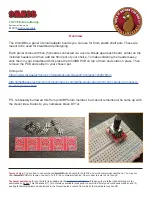
24
www.h2flow.net
• Upper-row display: MZ stands for the measured value of the empty pipe.
• Second-row display: Empty pipe zero-point correction value.
When increasing the down row correction value, the MR value increases, and when decreasing the downlink
correction value, the MR value decreases. User can adjust MR to an appropriate value according to actual
needs (it is recommended to adjust to MR=500), and the conductivity value of the actual empty tube is
basically the actual corrected MR value.
7.2.9 Damping Time of Empty Pipe
Long empty pipe damping time, slow response speed of empty pipe alarm. Short measurement damping
time empty pipe alarm response speed is faster, and the empty pipe damping time: 10 SEC, 15 SEC, 20 SEC,
25 SEC, 30 SEC, 35 SEC, 40 SEC, 45 SEC, 50 SEC, 60 SEC and can choose the setting mode.
7.3
Output Setup
7.3.1
Pulse Output Mode
The pulse output mode has two options: frequency output and pulse output:
PO frequency output mode:
The frequency output is a continuous square wave, and the frequency value
corresponds to the flow percentage.
Frequency output value = (measurement value of flow value / instrument flow range) * frequency range +
frequency lower limit.
Pulse output mode:
The pulse output is a rectangular wave pulse train. Each pulse represents a flow
equivalent in the pipeline. The pulse equivalent is set by the following two parameters “Pulse Equivalent
Unit” and “Pulse Equivalent”. The pulse output method is mostly used for total accumulation, and is generally
connected with an accumulation meter.
There are two types of pulse output: PO pulse output, DO pulse output:
PO pulse output:
this mode is if active pulse.
DO pulse output:
This mode is passive pulse output, isolated from 4-20mA output ground, and the
upper limit of pulse output is 500P/S (When this mode is selected, the alarm is only displayed and not
output).
Frequency and pulse output are generally in the form of OC Gate; therefore, an external DC power
supply and load should be connected. See sections 9.14 for details.
7.3.2 Pulse Equivalent
Pulse equivalent refers to the flow value represented by one pulse. The pulse equivalent of the instrument
needs to be set by the two parameters of “Pulse Equivalent Unit” and “Pulse Equivalent”. The range is 0.001 -
59.999m³, 0.001 - 59.999L, 0.001 - 59.999ukg, 0.001 -59.999usg, 0.001 - 59.999kg, 0.001 - 59.999t.
Under the same flow rate, if the pulse equivalent is small, the output pulse frequency is high and the
accumulated flow error is small.
















































